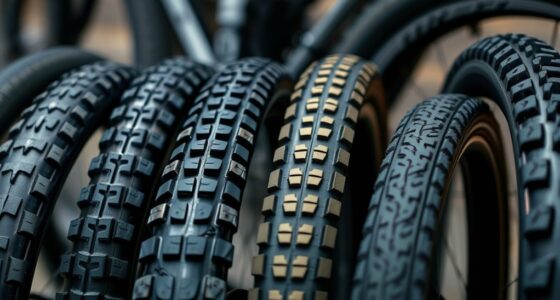To properly index your gears, first make certain your derailleur hanger is straight and your cables are clean and lubricated. Set the limit screws so the derailleur moves smoothly to the smallest and largest sprockets without rubbing. Then, fine-tune cable tension with the barrel adjuster for precise shifting. Perfecting these steps will help you achieve smooth, reliable gear changes, and you’ll discover even more tips by exploring further.
Key Takeaways
- Properly adjust limit screws to ensure the derailleur aligns with the smallest and largest sprockets.
- Fine-tune cable tension using the barrel adjuster for smooth, accurate gear shifts.
- Check and straighten the derailleur hanger to prevent misalignment and shifting issues.
- Lubricate and clean derailleur and cables regularly for consistent performance.
- Test shifts after each adjustment, making small tweaks to achieve precise, reliable gear indexing.
Understanding How Your Derailleur Works
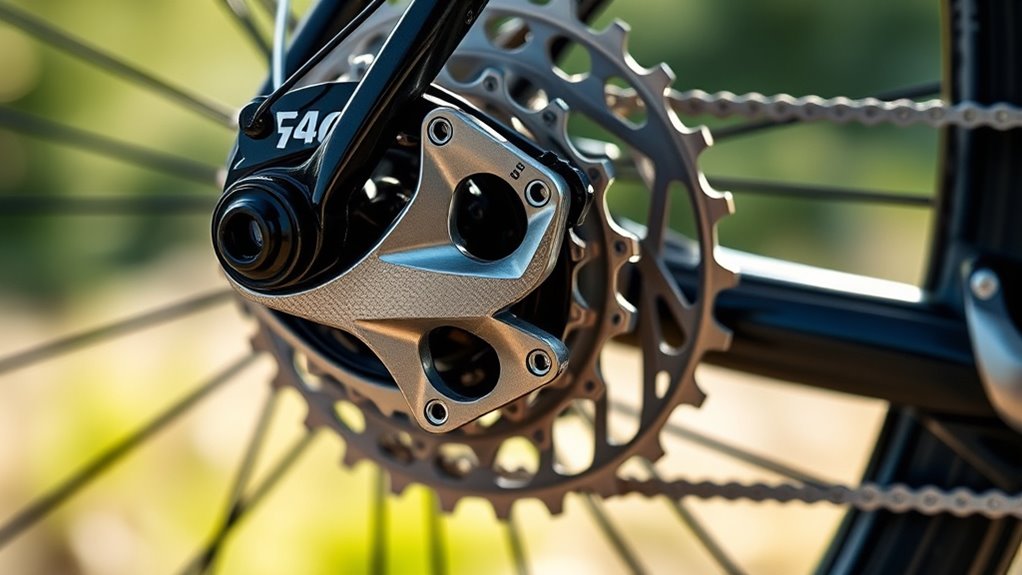
A derailleur is the component responsible for shifting your bike’s chain between gears, and understanding how it works is key to smooth shifting. The gear derailleur moves the chain across the sprockets, controlled by the shifting mechanism. When you operate the shifter, it pulls or releases a cable connected to the derailleur, causing it to pivot. This movement positions the derailleur’s jockey wheels, guiding the chain onto different gears. The derailleur’s spring tension guarantees it returns to a neutral position, maintaining chain tension. Knowing how the shifting mechanism interacts with the derailleur helps you diagnose issues and fine-tune your gears. Additionally, contrast ratio in projectors impacts the perceived sharpness and clarity of images, which is analogous to how precise gear alignment affects riding performance. Ultimately, a well-functioning derailleur ensures precise gear changes, making your ride smoother and more efficient.
Recognizing the Signs of Poor Gear Indexing

When your bike’s gears aren’t shifting smoothly, it’s a clear sign that something’s off with the indexing. Common signs include gear slippage, where the chain jumps between gears, and uneven shifts that feel jerky or delayed. You might notice the derailleur struggling to settle into the correct gear position or hear it make grinding noises. These issues often indicate misalignment or improper adjustment. To better understand, consider this:
| Sign | What it Means | Action Needed |
|---|---|---|
| Gear slippage | Chain jumps under load | Check derailleur alignment |
| Uneven shifts | Jerky or delayed responses | Fine-tune indexing |
| Inability to shift | Stuck in a gear | Inspect cable tension |
| Noisy gears | Grinding or squeaking | Realign derailleur |
| Skipping gears | Missing gear positions | Adjust derailleur limit screws |
Preparing Your Bike or E-Bike for Adjustment

Getting your bike or e-bike ready for gear adjustment starts with a thorough inspection. First, check your bike fit to ensure you’re comfortable and properly positioned, which helps with precise adjustments. Next, examine your tire pressure; properly inflated tires reduce rolling resistance and improve overall handling. Make sure both tires are at the recommended pressure, as under- or over-inflation can affect shifting performance. Inspect the derailleur and cables for any signs of wear or damage, cleaning and lubricating them if necessary. Confirm that the chain runs smoothly and is free of debris. Additionally, ensuring your components are properly maintained can prevent issues during gear indexing. By preparing your bike with a proper fit and ideal tire pressure, you create the best conditions for effective gear indexing, making adjustments easier and more accurate.
Properly Setting the Limit Screws

To guarantee your gears shift smoothly and stay within their intended range, you need to properly set the limit screws on your derailleur. These screws control how far the derailleur moves, ensuring gear compatibility and preventing chain drop or overshifting. Start by shifting to the smallest sprocket and adjusting the L-screw so the derailleur cage is close to the sprocket without rubbing. Then, shift to the largest sprocket and tweak the H-screw similarly. Proper derailleur alignment is key for accurate shifting, so check that the derailleur hangs straight and parallel to the cassette. Setting these screws correctly ensures your chain stays within the intended gear range and helps prevent shifting issues caused by misalignment or overly tight or loose limits. Using limit screws correctly is essential for maintaining optimal gear performance and prolonging component lifespan.
Adjusting the Barrel Adjuster for Smooth Shifting
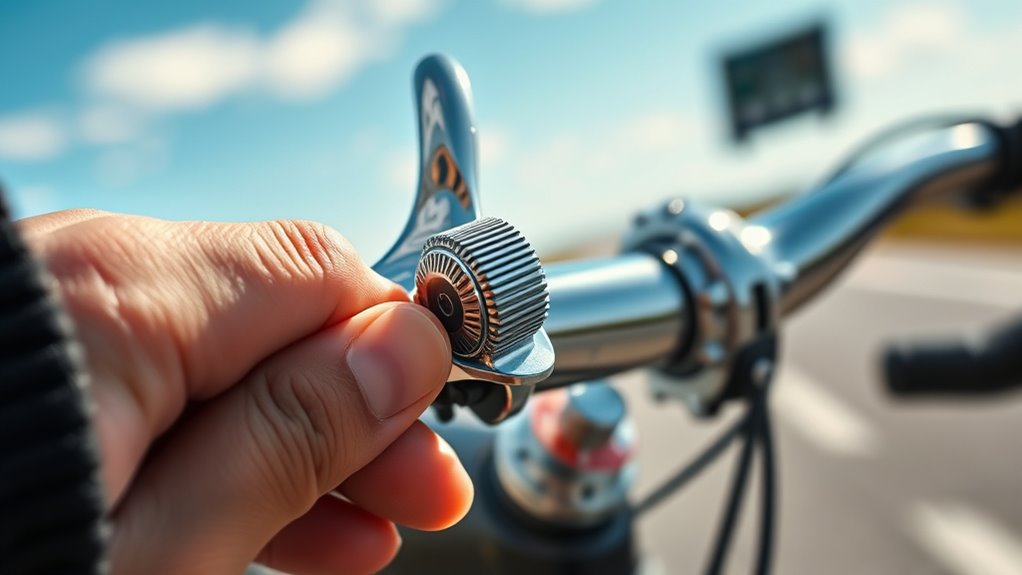
When you adjust the barrel adjuster, you’re fine-tuning cable tension to guarantee smooth shifts. If your bike isn’t shifting properly or feels jerky, recognizing these issues is key. Small tweaks can make a big difference in your riding experience.
Fine-tuning Cable Tension
Fine-tuning cable tension is essential for smooth and accurate gear shifting, and adjusting the barrel adjuster is a straightforward way to do it. Proper tension ensures your derailleur moves precisely and maintains gear compatibility. Before adjustment, make sure your cable is well-lubricated to reduce friction.
To fine-tune:
- Turn the barrel adjuster clockwise for tighter tension or counterclockwise for looser tension.
- Shift through gears to check if the derailleur responds smoothly.
- Ensure the derailleur hanger is straight.
- Confirm the cable runs clean and free of dirt or rust.
- Test shifting at different speeds to verify consistency.
Adjusting the barrel adjuster helps balance cable tension, preventing sluggish shifts or overshooting gears. Proper tension keeps your gears aligned and riding smooth.
Recognizing Shifting Issues
Are your gear shifts feeling rough, sluggish, or inconsistent? These issues often stem from chain slack or shifter compatibility problems. If your chain is too loose, it won’t engage gears smoothly, causing skipping or hesitation. Check for excessive chain slack by shifting to the smallest sprocket and inspecting the chain tension. Misaligned or incompatible shifters can also hinder performance, making precise indexing difficult. Recognize shifting issues early by noting if your gears won’t settle into proper positions or if you experience delayed responses when shifting. Adjusting the barrel adjuster can typically fix these problems by fine-tuning cable tension. Always confirm your shifters are compatible with your drivetrain components, as mismatched parts may require different adjustments or upgrades for ideal performance. Additionally, understanding gear indexing can help you troubleshoot and optimize your gear system more effectively.
Fine-Tuning the Indexing at the Shifter
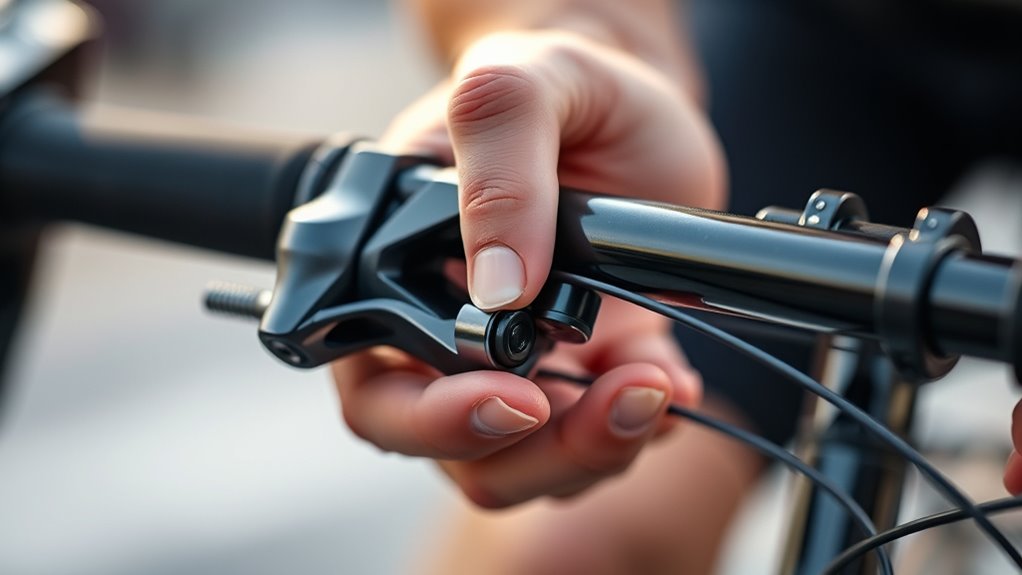
To make certain your gears shift smoothly, you need to fine-tune the indexing at the shifter. Start by checking that your gear lubrication is adequate, as dirt or dryness can hinder movement. Next, ensure your derailleur is compatible with your gear system to prevent misalignment. Adjust the barrel adjuster gradually to align the derailleur with the cassette or chainrings. Keep these tips in mind:
- Confirm gear compatibility between shifter and derailleur
- Clean and lubricate the gear cables regularly
- Turn the barrel adjuster in small increments
- Check for proper derailleur hanger alignment
- Test shifting after each adjustment
- Utilize apps or journals to track your gear changes and maintenance schedule
Fine-tuning your indexing guarantees smooth, precise shifts and prolongs gear system life. Proper attention to these details makes riding more enjoyable and efficient.
Troubleshooting Common Gearing Issues
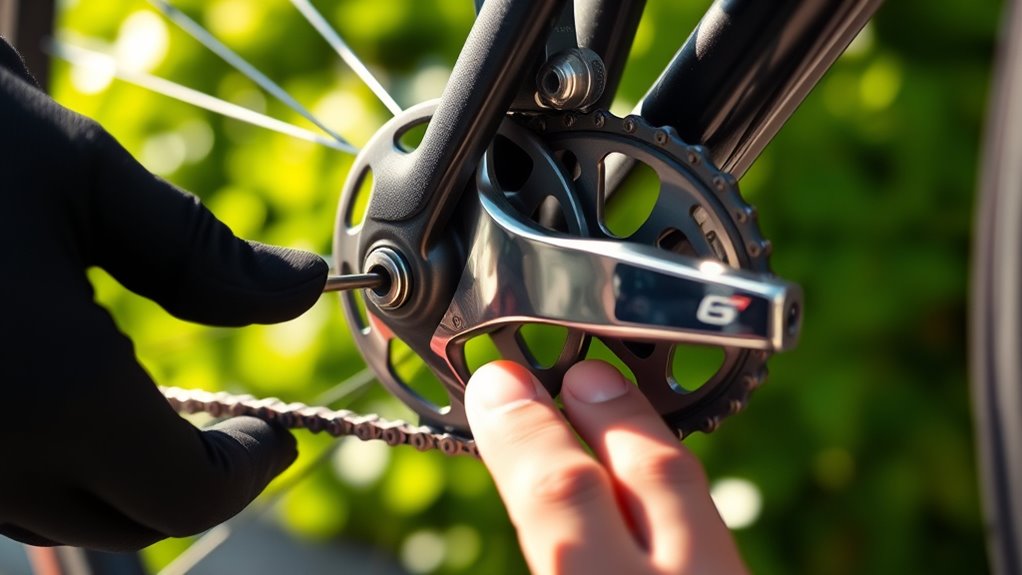
When your bike’s gears aren’t shifting smoothly or suddenly slip, it can be frustrating and hinder your ride. Start by checking gear lubrication; if the cables and derailleur aren’t well-lubricated, shifting becomes stiff or unresponsive. Clean and apply a suitable lubricant to reduce friction. Next, inspect frame alignment—if the frame is bent or misaligned, it can cause the derailleur to hang improperly, leading to poor gear changes. Make sure the derailleur hanger is straight and securely attached. Sometimes, shifting issues stem from cable tension problems, but ensuring proper lubrication and a straight frame often solves the most common problems. Proper Volkswagen Tuning can also improve overall performance, similar to how precise gear adjustments enhance your cycling experience. These simple steps can improve performance and make your shifting smoother and more reliable.
Maintaining Your Gears for Long-Term Performance

Regular maintenance is essential to keep your bike’s gears shifting smoothly over time. To facilitate long-term performance, regularly check and apply gear lubrication to prevent stiffness and squeaks. Keep your tire pressure at ideal levels to reduce stress on the drivetrain and improve shifting accuracy. Additionally, inspect your cables for wear and replace them if needed. Clean your derailleur and cassette to remove dirt and debris that can hinder shifting. Finally, test your gears after adjustments, guaranteeing smooth transitions across all gears. Incorporating proper climate control practices can also help maintain optimal conditions for your bike components, prolonging their lifespan.
Frequently Asked Questions
How Often Should I Reindex My Gears?
You should reindex your gears whenever you notice shifts are less precise or cable tension feels off, typically every few months or after a bike ride in rough conditions. Regularly checking and adjusting cable tension ensures smooth gear shifting and ideal gear accuracy. If you experience skipped gears or delayed shifting, reindex promptly. Consistent maintenance keeps your bike running smoothly and prolongs gear system lifespan.
Can I Upgrade My Derailleur for Better Shifting?
Upgrading your derailleur is like upgrading your bike’s engine—you can boost performance, but only if you check gear compatibility and derailleur capacity first. A better derailleur often offers smoother shifts and wider gear range, but guarantee it suits your cassette and chain. Before buying, verify compatibility with your current setup to avoid issues. With the right upgrade, you’ll enjoy more precise, effortless gear changes on every ride.
What’s the Best Lubricant for Gear Components?
You should use a high-quality gear oil designed specifically for bike components to keep your gears running smoothly. Apply it sparingly to the derailleur and chain, and wipe off excess to prevent dirt buildup. For maximum performance, lubricate your gear components every 100-200 miles or after riding in wet conditions. Regular lubrication frequency ensures smooth shifting and prolongs your drivetrain’s lifespan, so don’t skip these essential maintenance steps.
How Do Weather Conditions Affect Gear Indexing?
Like a weather vane, your gears respond to rain impact and temperature effects. Rain can cause grime buildup, making indexing tricky, while cold weather stiffens cables and shifters, reducing precision. Hot days can expand components, leading to misalignment. To keep your gears smooth, regularly clean and lubricate, and adjust your indexing as weather changes. Staying aware of these effects helps you maintain ideal shifting, no matter the forecast.
Is It Necessary to Replace Cables Regularly?
You don’t need to replace cables regularly, but keep an eye on cable corrosion, which can cause poor gear alignment. If you notice sluggish shifting or frayed cables, it’s time for a replacement. Regular inspections help. Cleaning and lubricating cables can extend their life. Replacing cables when they show signs of corrosion or wear ensures your gears stay smooth and responsive, preventing unnecessary adjustments and maintaining peak performance.
Conclusion
Think of gear indexing as tending a delicate garden. With patience and care, you nurture each part to work in harmony, ensuring smooth rides and fewer surprises. When you understand your derailleur and make small adjustments, you’re cultivating a landscape of effortless shifting. Keep tending to your bike’s gears regularly, and they’ll reward you with seamless performance—showing that, like a thriving garden, consistent attention turns small efforts into lasting harmony.


